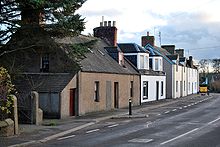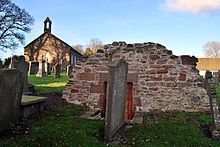- Marykirk
-
Marykirk (Scottish Gaelic: Obar Luathnait) is a small village in Aberdeenshire, Scotland next to the border with the county of Angus at the River North Esk.
The village is approximately 6 miles ENE of Montrose at the southern end of the Howe of the Mearns. The road bridge carrying the A937 over the River North Esk is a substantial structure with four arches. It was designed by Robert Stevenson and completed in 1815 at the cost of £1,000 replacing the previous route to the village an ancient ford. There is a rail bridge across the same river some 600 m north of the road bridge and the village once had a rail station to the north east.
The present parish church was rebuilt in 1806 replacing the previous church the remains of which can be found in the adjacent kirkyard. The older church was dedicated to St Mary and consecrated in 1242 by the Bishop de Bernham. The centre of the village has an ancient market cross. The grand gates to the now demolished mansion Kirktonhill House, once the home of oil merchant R W Adamson, can be found still in position (Google Street View). Once boasting many small businesses supporting the surrounding agricultural lands the village now only has a part-time Post Office. [1]
The village also has a small primary school of two teachers with between 20 and 30 pupils. [2] as well as an Hotel, the 19th century coaching House, The Marykirk Hotel. [3] (Google Street View)
Since 1996 the willage has been holding an annual Raft Race in the River North Esk which normally takes place on the Last Sunday in May. Aftrer six years of holding the race it came to a halt as a committee couldn't be formed to organise it. Then in 2009 a committee formed and The Raft Race started once again. It still continues and Marykirk is looking forward to hosting the Raft Race in May this year.[http://www.marykirkraftrace.com Since starting the race again in 2009 the race has attracted 37 rafts and has raised over £9,000 for charity. The committee for the 2009 race consisted of Kay Mcdonld, Eric Whyte, Wilma Walker, Ronnie Reid, Bill Buchan, Alison Dodds, Barbara Officer, Simon Roberts and Gill.
Charities money raised for in 2009/10:
2009: Children's Hospice Association Scotland (CHAS) Craighalbert Red Cross Alzheimers Stonehaven Branch Multiple Sclerosis Royal British Legion Montrose Cancer Link Aberdeen North Macmillian Strathcathro Marie Curie Cancer Care WRI Pensioners Club Lunch Club Marykirk Football Club Bumps, Babes and Toddlers Marykirk Bowling Club
2010: Children's Hospice Association Scotland (CHAS) Craighalbert St Andrews Alzheimers Stonehaven Branch Multiple Sclerosis Royal British Legion Montrose Cancer Link Aberdeen North Macmillian Strathcathro Marie Curie Cancer Care Erskine House
Marykirk was also the site of the world's first first electricity generating wind turbine, built by James Blyth to light his summer residence in the village.[1]Up until the end of July 2010, the village also has its own amateur Weather Station [4]
References
- ^ Price, Trevor J. (2004). "Blyth, James (1839–1906) (subscription required)". Oxford Dictionary of National Biography. Oxford University Press. http://www.oxforddnb.com/public/dnb/100957.html. Retrieved 9 October 2009.
Sources
- Marykirk in the Gazetteer for Scotland.
- Marykirk in The History of the Howe.
- Marykirk Hotel.
- Marykirk Primary School.
- The Marykirk Raft Race
- The Marykirk Weather Station (shut down July 2010)
Settlements and places of interest in Kincardine and Mearns, Aberdeenshire Primary settlements Auchenblae · Drumoak · Fettercairn · Gourdon · Inverbervie · Johnshaven · Laurencekirk · Newtonhill · Portlethen · St Cyrus · Stonehaven

Other settlements Arbuthnott · Banchory-Devenick · Bridge of Muchalls · Cammachmore · Catterline · Cookney · Downies · Drumlithie · Findon · Fordoun · Glenbervie · Kinneff · Kirkton of Durris · Maryculter · Marykirk · Muchalls · Netherley · Portlethen Village
Places of interest Causey Mounth · Crawton · Drum Castle · Dunnottar Castle · Fetteresso Castle · Fowlsheugh Nature Reserve (Craiglethy) · Monboddo House · Muchalls Castle · Normandykes · Portlethen Moss · Raedykes · Stonehaven Open Air Pool · Stonehaven Tolbooth
Areas and primary settlements in Aberdeenshire
(see also: Aberdeen City)in Banff and Buchan Aberchirder · Banff · Fraserburgh · Gardenstown · Inverallochy and Cairnbulg · Macduff · Portsoy · Rosehearty · Sandhaven · Whitehills

in Buchan Boddam · Crimond · Cruden Bay · Fetterangus · Hatton · Longside · Maud · Mintlaw · New Deer · New Pitsligo · Peterhead · St Combs · St Fergus · Strichen · Stuartfield
in Formartine Balmedie · Cuminestown · Ellon · Fyvie · Newburgh · Oldmeldrum · Pitmedden · Potterton · Rothienorman · Tarves · Turriff
in Garioch in Kincardine and Mearns Drumoak · Fettercairn · Gourdon · Inverbervie · Johnshaven · Laurencekirk · Newtonhill · Portlethen · St Cyrus · Stonehaven
in Marr Coordinates: 56°46′N 2°31′W / 56.767°N 2.517°W
Categories:- Villages in Aberdeenshire
- Aberdeenshire geography stubs
Wikimedia Foundation. 2010.



